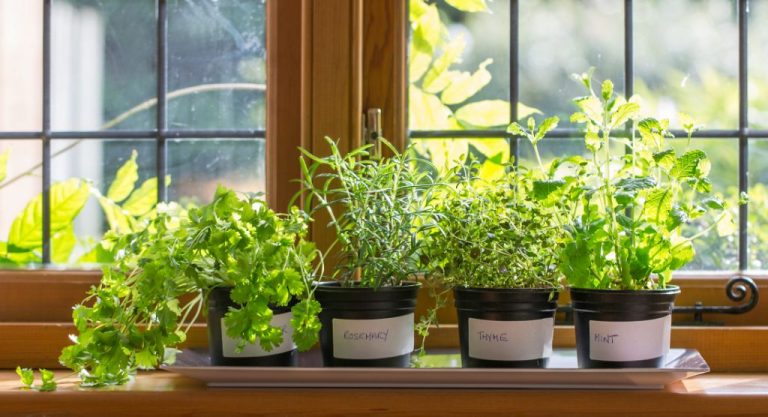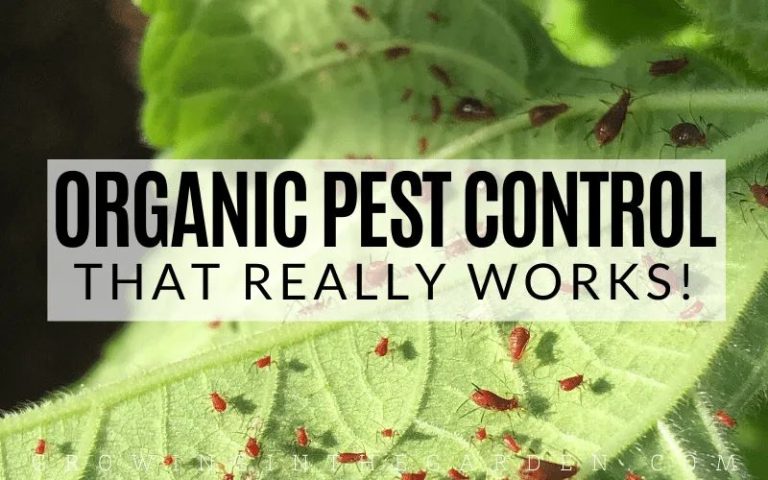Organic Garden Pest Prevention: Strategies For Healthy Plants
Organic gardening aims to grow plants without the use of synthetic pesticides or fertilizers. Instead, organic growers rely on natural methods and materials to cultivate healthy plants and control pests. Some of the most common garden pests include aphids, Japanese beetles, caterpillars, spider mites, slugs, and fungi. Preventing pests is a key part of organic gardening, as synthetic pesticides are prohibited. Stopping pest problems before they start saves plants and avoids the need for harsh chemical treatments later on. According to the gardenary blog, prevention is the most effective organic pest control method.
Beneficial Insects
Certain insects can help control pests naturally in an organic garden. Some beneficial insects include ladybugs, lacewings, and praying mantises. These predators prey on common garden pests like aphids, mites, and caterpillars (https://www.lowes.com/n/how-to/organic-gardening).
Ladybugs
Ladybugs (or ladybird beetles) are a gardener’s best friend. Both the adult and larval stages feed on soft-bodied insects like aphids, mealybugs, spider mites, and scale. A single ladybug can eat up to 50 aphids per day. To attract ladybugs to your garden, plant pollen and nectar-rich flowers like daisies, coreopsis, and yarrow (https://keetonpr.com/project/ace-hardware/page/3/?et_blog).
Lacewings
Lacewings are known for their delicate, vein-filled wings. The larvae (called aphid lions) are ferocious predators that consume soft-bodied pests like aphids, thrips, and mites. Adult lacewings feed on nectar, pollen, and honeydew. Attract them by planting flowers like cosmos, dandelions, and goldenrod.
Praying Mantises
Praying mantises are formidable hunters that capture and eat a wide variety of insects like beetles, moths, crickets, and caterpillars. They patience and stealth allow them to ambush unwitting pests. To invite mantises, avoid pesticide use and provide safe habitat like flowering plants and shrubs.
Crop Rotation
Crop rotation works by planting families of crops in different locations in the garden each year. By rotating crops, gardeners can disrupt the life cycles of common pests and reduce the likelihood of severe infestations. Crop rotation helps prevent the buildup of pathogens and pests that can overwinter in the soil and attack the same crops year after year (https://ecomeadow.in/effective-organic-pest-control-methods/).
When planning a crop rotation schedule, it’s important to understand which crops are related to each other and susceptible to the same pests. Common crop families to rotate include nightshades (tomatoes, peppers, eggplant), cucurbits (cucumbers, squash, melons), brassicas (cabbage, kale, broccoli), and root vegetables (carrots, beets, radishes).
A simple rotation is to divide the vegetable garden into quarters, and plant each of the crop families in a different quarter each year. An example 4-year rotation plan could be:
Year 1: Nightshades in Plot A, Cucurbits in Plot B, Brassicas in Plot C, Roots in Plot D
Year 2: Roots in Plot A, Nightshades in Plot B, Cucurbits in Plot C, Brassicas in Plot D
Year 3: Brassicas in Plot A, Roots in Plot B, Nightshades in Plot C, Cucurbits in Plot D
Year 4: Cucurbits in Plot A, Brassicas in Plot B, Roots in Plot C, Nightshades in Plot D
Thoughtful crop rotation can help create a healthy garden ecosystem and is an effective organic approach to prevent common vegetable pests.
Companion Planting
Companion planting works by strategically grouping together plants that help each other grow. Certain plants have natural properties that repel pests, attract beneficial insects, improve soil nutrients, or provide shade and support for neighboring plants. By pairing compatible plants together, you can create a garden ecosystem that naturally resists garden pests.
Some classic companion planting combinations include:
- Basil planted with tomatoes helps repel pests like mosquitoes, aphids, and hornworms. (Source)
- Marigolds interplanted with vegetables help deter beetles, nematodes, and other garden pests.
- Planting garlic or chives near roses helps repel aphids.
- Nasturtiums or radishes around cucumbers and squash improve pest resistance.
It’s also important to avoid pairing incompatible plants. For example, onions and beans stunt each other’s growth when planted together. Pay attention to each plant’s space requirements, soil needs, and growing seasons as well.
With some research and experimentation, you can discover plant combinations that thrive together in your specific garden environment. The key is observing interactions between plants and noting positive or negative effects over time.
Natural Pest Repellents
Natural pest repellents derived from plants offer an eco-friendly alternative to synthetic chemical pesticides. Some commonly used natural repellents include essential oils, neem oil, and kaolin clay.
Essential oils like peppermint, thyme, and garlic can deter common garden pests. Mix a few drops of oil with water and spray directly on plants. The strong aroma repels insects while the oil coats leaves with a barrier. Peppermint oil specifically targets ants, aphids, spider mites, and beetles.1
Extracted from the neem tree, neem oil contains azadirachtin that insects find unappealing. In addition to repelling pests, it also works as an insecticide against soft-bodied insects like aphids, mites, and caterpillars. Mix neem oil with water and a mild soap, then spray on plants. For best results, apply in the early morning or late evening every 7-14 days.2
Kaolin clay spray coats plant surfaces with a fine powder that deters pests from feeding. It is especially useful against soft-bodied pests like aphids, mites, and psyllids. Mix kaolin clay with water and spray directly on leaf surfaces for protection. Reapply after heavy rain as needed.2
Physical Barriers
Physical barriers provide a simple yet effective way to protect plants from pests. Some common types of physical barriers include:
Floating Row Covers: These lightweight covers are made from spun polyester or polypropylene fabric. They “float” over plants, forming a protective barrier against insect pests. Floating row covers allow air, light, and water through while keeping pests out. They can be used to cover rows or individual plants. According to GrowVeg, floating row covers are especially useful for preventing cabbage moths, carrot flies, and flea beetles.
Garden Netting: Netting made from nylon or polypropylene can be draped over plants or used to construct protective cages. Deer netting with a small mesh size (e.g. 5/8″) can keep out small pests like Japanese beetles. Netting helps deter larger animals like rabbits and deer. As recommended by Hobby Farms, upright or dome-shaped netting structures are ideal for protecting berry bushes or vegetable plants.
Collars: Collars wrapped around plant stems provide a barrier against crawling insects. Aluminum foil, flexible plastic, or other material can be used. Collars should be snugly fitted and extend 2-3 inches into the ground. They are especially useful for protecting seedlings from cutworms and other ground-dwelling pests.
Sanitation
One of the most effective ways to prevent pests and disease in an organic garden is through proper sanitation practices. This involves removing and disposing of any diseased plant material, clearing away debris that pests can hide in, and disinfecting tools to prevent spreading disease. According to the University of Nebraska-Lincoln, “As you can see, sanitation is very important for reducing disease and insect pressure in your garden or landscape each year.”1
It’s crucial to immediately remove and discard any plants showing signs of disease, as well as prune off affected branches or leaves on plants you want to save. The University of California Integrated Pest Management Program recommends destroying the pruned material right away so it doesn’t become a source of new infections.2 Also, uproot old plant stumps and roots, which can harbor pests.
Likewise, clear away fallen leaves, straw, boards, stones, or other debris where slugs, snails, and other pests can hide. Keep the garden free of weeds, which can compete with plants and provide cover for insects. Disinfect any tools after pruning or cutting diseased plants.
With proper sanitation measures, the garden environment will be less hospitable to diseases and pests.
Biological Pesticides
Biological pesticides, also known as biopesticides, are derived from natural materials like plants, bacteria, fungi, and certain minerals. They work by targeting the specific pest without harming beneficial insects or the overall environment. Biological pesticides provide an effective organic solution for controlling garden pests.
Bacillus thuringiensis (Bt) is a common active ingredient in organic biological pesticides. It is a naturally occurring bacteria that kills larvae of certain insect pests like cabbage worms but is not toxic to people or beneficial insects like bees and ladybugs. Products with Bt specifically target caterpillars and beetle larvae when they ingest the treatment while feeding on leaves. Once ingested, Bt produces toxins that damage the insect’s digestive system, causing them to stop eating and ultimately die within a few days [1].
Another biological pesticide, spinosad, is derived from the fermentation of a naturally occurring soil bacteria. It effectively controls chewing and sucking insect pests like thrips, borers, beetles, and caterpillars. Spinosad has little to no effect on beneficial insects when used properly and degrades quickly in sunlight. Like Bt, it is an organically certified and environmentally safe method for protecting plants from damaging pests [2].
Biological pesticides provide organic gardeners with safe and effective options for pest prevention and management. Products containing Bt or spinosad can target hungry larvae while avoiding negative impacts on bees, butterflies, and other beneficial species.
Cultural Practices
Implementing certain cultural practices can help prevent pest problems and promote plant health in an organic garden.1 Proper watering, fertilizing, and pruning are key cultural practices that create strong, healthy plants that are more resistant to pests and diseases.
Overwatering or underwatering plants creates stress and makes them more susceptible to pest issues. It’s important to monitor soil moisture and water appropriately based on each plant’s needs. Adding organic fertilizer at the right times provides nutrients to help plants grow vigorously.
Regular pruning removes damaged growth and encourages new, healthy shoots. It also improves air circulation between plants, preventing fungal issues. Pruning controls plant size and shape for better yields. Removing spent flowers and fruits through pruning limits areas where pests can feed and reproduce.
By focusing on proper watering, fertilizing, and pruning, you can grow robust plants in your organic garden. These cultural practices help prevent pest problems by reducing plant stress and promoting vigorous growth.
Monitoring and Identification
One of the most effective ways to prevent pests is through careful monitoring and early identification. Being vigilant about checking your garden regularly allows you to spot infestations while they are still small and manageable. Here are some tips for monitoring and identifying common organic garden pests:
Walk through your garden at least once a week and thoroughly inspect plants. Look on the undersides of leaves, at the base of plants, and in the top layers of soil for any signs of pests. Common things to look for include chewed leaves, spots/discoloration, wilting, webs, frass, and the pests themselves. A 10x magnifying glass can help you identify tiny pests.
Learn to identify the most common pests in your area, as well as their eggs and larvae. Some frequent organic garden invaders include aphids, spider mites, cabbage worms, squash bugs, Colorado potato beetles, snails, and tomato hornworms. If you spot just a few pests, manually remove them. For larger infestations, intervene quickly with appropriate organic treatments.
Setting up sticky traps is another easy monitoring method. The trapped insects can then be identified and counted to determine if pest populations are rising. Yellow and blue sticky cards tend to attract more pests.
Keeping detailed records of what pests you find and when will help you notice patterns and stay one step ahead in future seasons. Knowing when certain pests appear allows you to be prepared to take preventative action.
Early detection through vigilant monitoring and identification is one of the best defenses against major pest infestations. Being proactive gives you the upper hand against invasive insects and diseases.
Sources:
https://qazami.com/gardening/ravenous-intruders-garden-pests/






